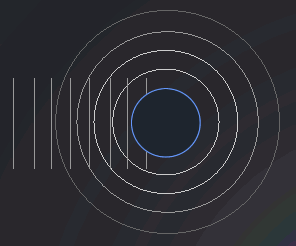 |
 |
|
 |
 |
| Glory & Telescopes Brigitta Sipocz imaged this glory on Christmas Day 2010 on La Palma, Spain. The island has exceptionally good atmospheric conditions and is the home of several major telescopes. The multi-ringed glory surrounds the shadow of the INT (Isaac Newton Telescope). The JKT (Jacobus Kapteyn Telescope) is to the right and Mercator to the left. ©Brigitta Sipocz, shown with permission. |
 |
 |
|
 |
 |

| About - Submit | Optics Picture of the Day | Galleries | Previous | Next | Today |
| In the early 1860s the Scottish physicist and mathematician James Clerk Maxwell published four equations that most succinctly, beautifully and exactly express classical electricity and magnetism. When written for periodic electric and magnetic fields, the equations describe the behaviour of light. When Maxwell�s equations are applied to the instance of a plane wave (for example sunlight) interacting with a homogeneous sphere (a water droplet) they produce further equations that describe - without any approximation - the resulting light scattering. All this was achieved in the early 1900s by several workers but mainly Gustav Mie and Ludvig Lorenz. The theory is generally known as Mie scattering. The theory automatically takes account of all the optical processes and interactions, e.g. diffraction around the drop, reflections from the drop surface, transmission through the drop, internal reflections and so on. No extra physical insight is needed beyond the initial formulation. Solutions automatically produce a corona, a fogbow or rainbow and a glory opposite the sun. They are a triumph of mathematical physics. Ironically, all this exactitude and elegance gives few clues to what is actually happening! We have alternative - but approximate - mental models that help us to comprehend the corona and rainbow. Simple models for the glory are, however, lacking and we are left with an exact theory but wont of insight. Nonetheless, some understanding can be derived from alternative formulations of the scattering theory and Philip Laven�s recent work helps us see what is happening when light forms a glory. For decades, numerical predictions from the exact Mie-Lorenz scattering theory were rarely attempted because the arithmetic was so laborious and time consuming. Now, the solutions are produced in seconds as in the IRIS simulation at right. |
